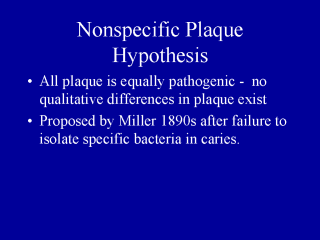|
|
|
|
front |1 |2 |3 |4 |5 |6 |7 |8 |9 |10 |11 |12 |13 |14 |15 |16 |17 |18 |19 |20 |21 |review |
 |
The nonspecific plaque hypothesis
maintains that all plaque has equal potential to cause destructive dental
disease. This means one does not need to differentiate disease associated plaque
from health associated plaque because no differences exist between the dental
plaque present in healthy mouths and those present in the mouths with
periodontitis and rampant caries. 8
Historically, periodontal treatment developed around the idea that caries and periodontitis was caused by nonspecific bacterial overgrowth. These ideas led to treatment protocols designed to suppress the entire flora by removing plaque from tooth surfaces as thoroughly as possible every day. When plaque control failed, surgical intervention allowed better plaque control. When surgery failed, broad spectrum antibiotics were used in attempts to suppress the entire plaque flora without regard to the possibility that only certain specific species were responsible for the infections. This idea was first forwarded by Miller in the 1890ís to explain the cause of caries. Miller developed his ideas after failing to isolate specific bacteria from carious lesions. We know now that the periodontal pathogens are anaerobic 8,15,17 and that it would have been impossible for Miller to isolate and grow these since he did not use anaerobic chambers. |